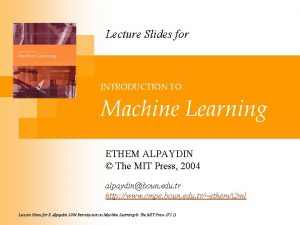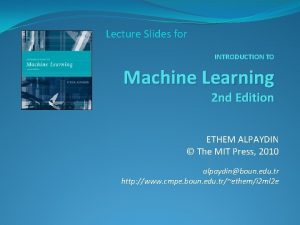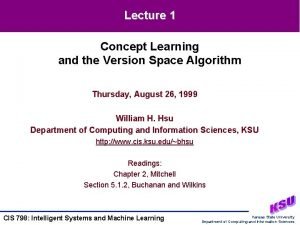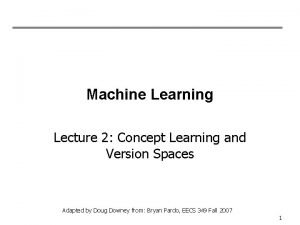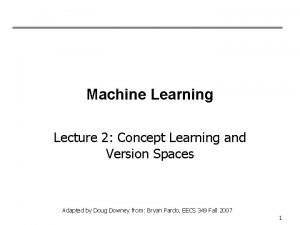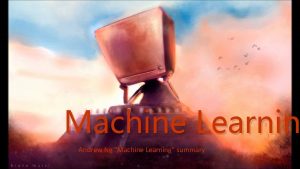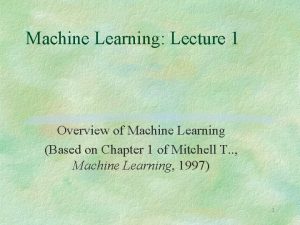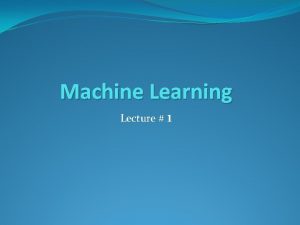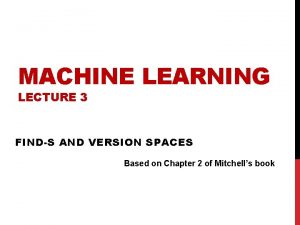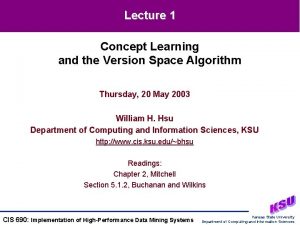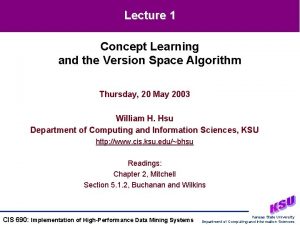MACHINE LEARNING LECTURE 2 CONCEPT LEARNING AND VERSION


















- Slides: 18

MACHINE LEARNING LECTURE 2 CONCEPT LEARNING AND VERSION SPACES 1 Based on Chapter 2 of Mitchell’s book

OUTLINE • Concept Learning from examples • Hypothesis representation • General-to specific ordering of hypotheses 2 • the Find-S algorithm

WHAT IS A CONCEPT? • Assume a given domain, e. g. objects, animals, etc. • A Concept is a subset of the domain, e. g. birds⊆animals Things Birds Animals Cars 3 • Generally we can’t look at all objects in the domain

WHAT IS A CONCEPT? • A Concept could be defined as a Boolean-valued function C defined over the larger set • Example: a function defined over all animals whose value is true for birds and false for every other animal. c(bird) = true c(cat) = false c(car) = false c(pigeon) = true 4 • •

WHAT IS CONCEPT LEARNING? • Given a set of examples labeled as members (positive) or non-members (negative) of a concept: 5 • Infer the general definition of this concept • Approximate c from training examples: • Infer the best concept-description from the set of all possible hypotheses

EXAMPLE OF A CONCEPT LEARNING TASK • Concept: Good days on which my friend enjoys water sport (values: Yes, No) • Task: predict the value of ”Enjoy Sport” for an arbitrary day based on the values of the other attributes • Result: classifier for days Temp Humid Sunny Rainy Sunny Warm Cold Warm Normal High Wind Water Strong Warm instance Strong Warm Cool Forecast Enjoy Sport Same Change Yes No Yes 6 Sky attributes

REPRESENTING HYPOTHESES • • Many possible hypothesis (h) representations • Each constraint can be: The simplest h could be represented as a conjunction of constraints over the instance attributes a specific value (e. g. , Water = Warm) ? : don’t care/any value (e. g. , Water=? ) no value allowed (e. g. , Water=Ø) • Example: hypothesis h Sky Temp Humid Wind Water Forecast < Sunny ? ? Strong ? Same > • We say h(x)=1 for a day x, if x satisfies the description 7 • • •

MOST GENERAL/SPECIFIC HYPOTHESIS every day is a positive example 8 No day is a positive example

PROTOTYPICAL CONCEPT LEARNING TASK • GIVEN: • Instances X: Possible days, each described by the attributes sky, Air. Temp, Humidity, Wind, Water, Forecast • Target function c: Enjoy. Sport: X {0, 1} • Hypotheses H: Conjunctions of constraints on attributes <? , Cold, High, ? , ? > • Training examples D: positive and negative examples of the target function <x 1, c(x 1)>, <x 2, c(x 2)>, …, <xn, c(xn)> • DETERMINE: 9 • A hypothesis h in H with h(x)=c(x) for all x in D

THE INDUCTIVE LEARNING HYPOTHESIS • Any hypothesis found to approximate the target function well over the training examples, will also approximate the target function well over the unobserved examples. Tom Mitchell • Assumptions for Inductive Learning Algorithms: 10 • The training sample represents the population • The input attributes permit discrimination

NUMBER OF INSTANCES, CONCEPTS, HYPOTHESES Learning can be viewed as a task of searching a large space • Sky: Sunny, Cloudy, Rainy 11 • Air. Temp: Warm, Cold • Humidity: Normal, High • Wind: Strong, Weak • Water: Warm, Cold • Forecast: Same, Change #distinct instances : 3*2*2*2 = 96 #distinct concepts : 296 #syntactically distinct hypotheses : 5*4*4*4=5120 (general and specific cases are added) #semantically distinct hypotheses : 1+4*3*3*3=973

CONCEPT LEARNING AS SEARCH • Learning can be viewed as a task of searching a large space 12 • Different learning algorithms search this space in different ways!

GENERAL-TO-SPECIFIC ORDERING OF HYPOTHESIS • Many algorithms rely on ordering of hypothesis • Consider two hypotheses: • h 1=(Sunny, ? , Strong, ? ) • h 2= (Sunny, ? , ? , ? ) h 2 imposes fewer constraints than h 1: it classifies more instances x as positive h(x)=1 h 2 is more general than h 1! 13 • How to formalize this?

GENERAL-TO-SPECIFIC ORDERING OF HYPOTHESIS • Many algorithms rely on ordering of hypothesis • Consider two hypotheses: • h 1=(Sunny, ? , Strong, ? ) • h 2= (Sunny, ? , ? , ? ) h 2 imposes fewer constraints than h 1: it classifies more instances x as positive h(x)=1 h 2 is more general than h 1! • How to formalize this? 14 • h 2 is more general than h 1 iff h 2(x)=1 h 1(x)=1 • We note it h 2 ≥g h 1

INSTANCE, HYPOTHESES, AND MORE-GENERAL Instances Hypotheses specific x 1 h 3 x 2 h 2 h 1 h 2 h 3 h 1 h 2 general x 1=< Sunny, Warm, High, Strong, Cool, Same> h 1=< Sunny, ? , Strong, ? > x 2=< Sunny, Warm, High, Light, Warm, Same> h 2=< Sunny, ? , ? , ? > The ≥g relation is important as it provides a structure over the hypothesis space. 15 h 3=< Sunny, ? , ? , Cool, ? >

FIND-S ALGORITHM Initialize h to the most specific hypothesis in H: For each positive training instance x: For each attribute constraint ai in h: If the constraint is not satisfied by x Then replace ai by the next more general constraint satisfied by x 16 Output hypothesis h

FIND-S Example Sky Air. Temp Humidity Wind Water Forecast Enjoy. Sport 1 Sunny Warm Normal Strong Warm Same Yes 2 Sunny Warm High Strong Warm Same Yes 3 Rainy Cold High Strong Warm Change No 4 Sunny Warm High Strong Cool Change Yes h=< , , , > h = <Sunny, Warm, Normal, Strong, Warm, Same> h = <Sunny, Warm, ? , Strong, ? > 17

FIND-S Example Sky Air. Temp 1 Sunny Warm Normal Strong Warm Same Yes 2 Sunny Warm High Strong Warm Same Yes 3 Rainy Cold High Strong Warm Change No 4 Sunny Warm High Strong Cool Change Yes h = <Sunny, Warm, Humidity ? Wind , Strong, Water ? , Forecast Enjoy. Sport ? > Prediction 5 Rainy Cold High Strong Warm Change No 6 Sunny Warm Normal Strong Warm Same Yes 7 Sunny Warm Low Strong Cool Same Yes 18
 Concept learning task in machine learning
Concept learning task in machine learning Introduction to machine learning slides
Introduction to machine learning slides Machine learning lecture notes
Machine learning lecture notes Machine learning lecture notes
Machine learning lecture notes 01:640:244 lecture notes - lecture 15: plat, idah, farad
01:640:244 lecture notes - lecture 15: plat, idah, farad Inductive and analytical learning
Inductive and analytical learning Inductive analytical approach to learning
Inductive analytical approach to learning Eager leaner
Eager leaner Hypothesis space in machine learning
Hypothesis space in machine learning Intermediate pressure system anesthesia machine
Intermediate pressure system anesthesia machine Analytical learning in machine learning
Analytical learning in machine learning Pac learning model in machine learning
Pac learning model in machine learning Pac learning model in machine learning
Pac learning model in machine learning Instance based learning in machine learning
Instance based learning in machine learning Inductive learning machine learning
Inductive learning machine learning First order rule learning in machine learning
First order rule learning in machine learning Cmu machine learning
Cmu machine learning Mealy and moore model
Mealy and moore model Differentiate between simple machine and compound machine
Differentiate between simple machine and compound machine


